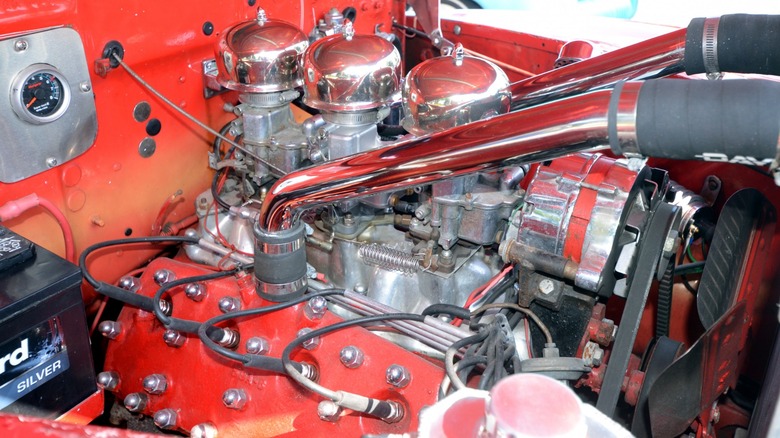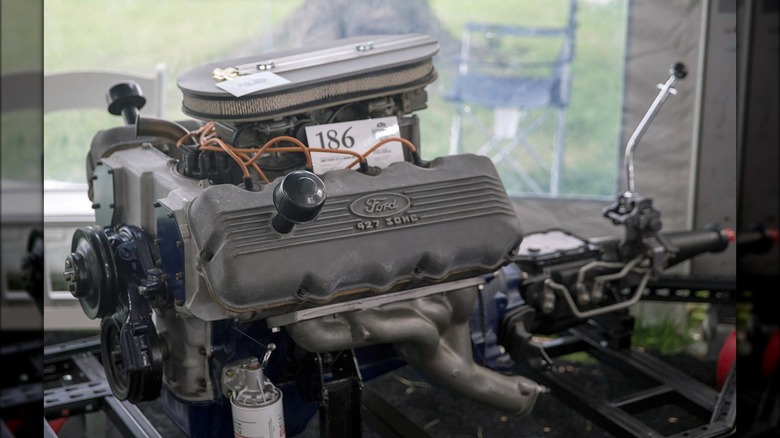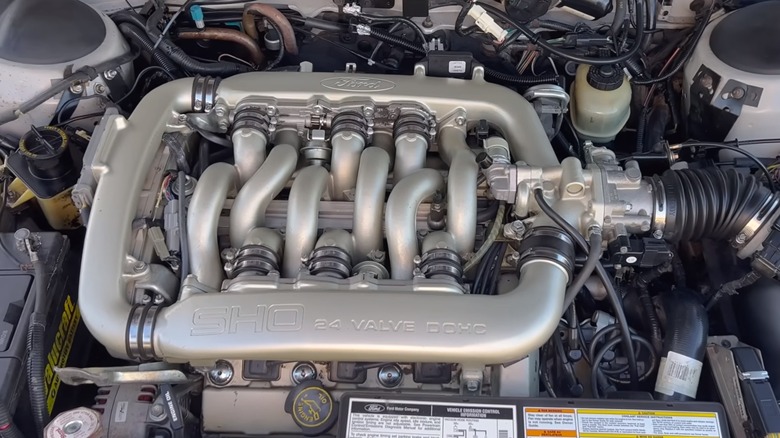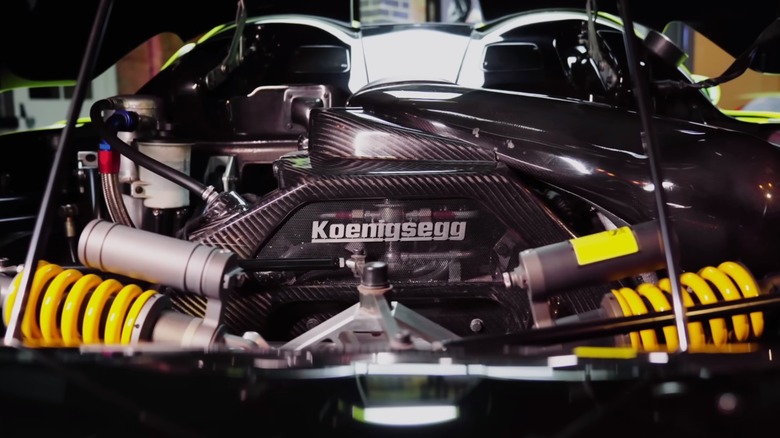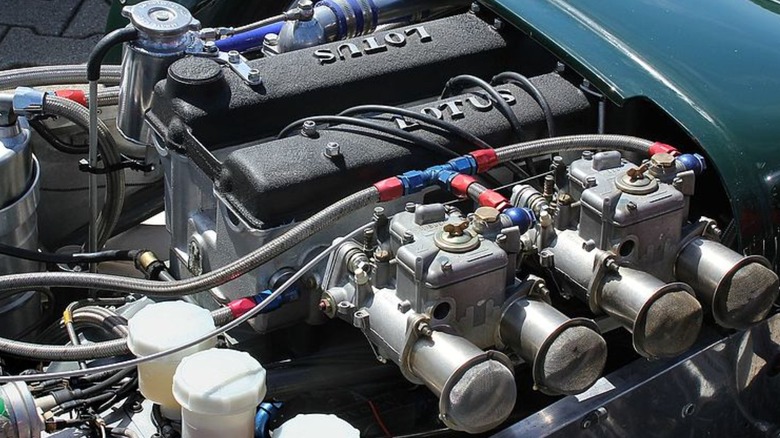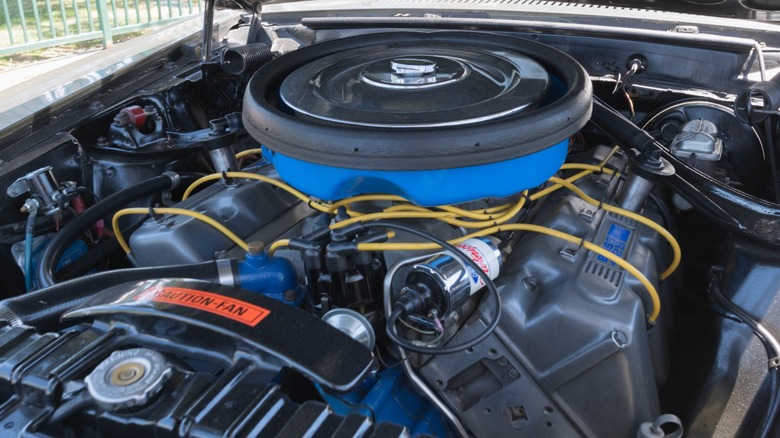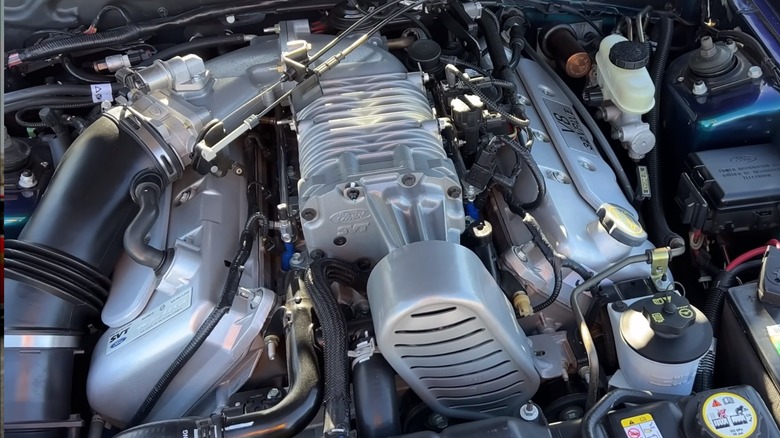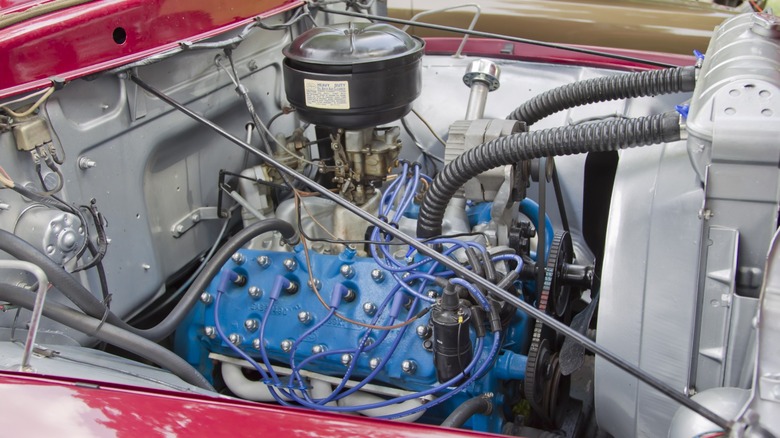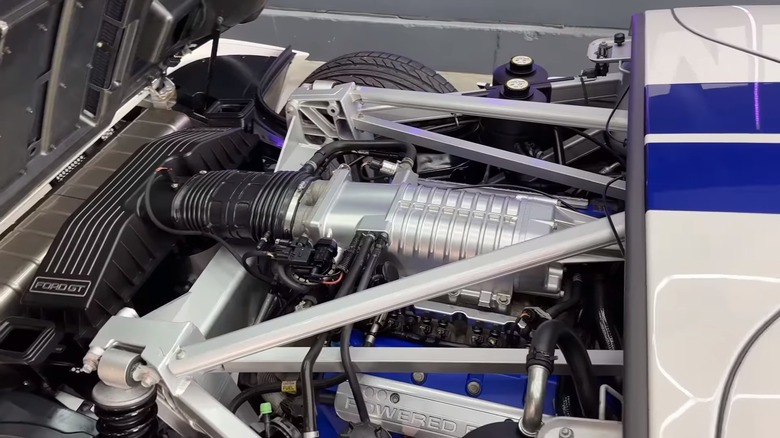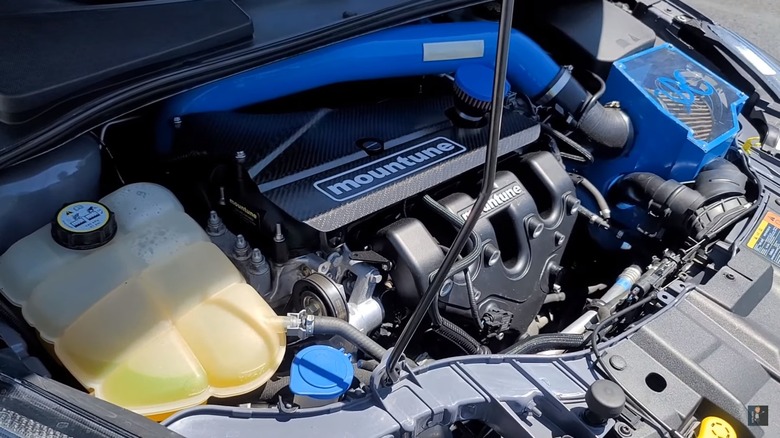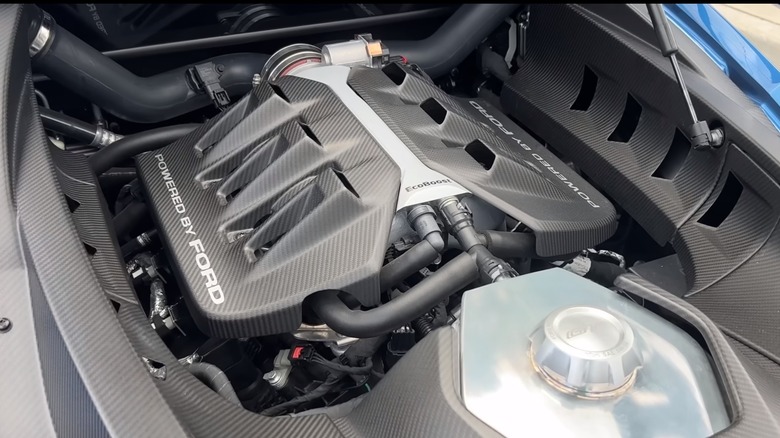10 Of The Most Impressive Ford Engines Ever Built
Thanks to the success of the Model T, the Ford Motor Company has been sending an array of engines into the world powering cars, trucks, tractors, and even airplanes. Early innovations in designing machines that would be reliable and affordable have given way to efficient and effective manufacturing processes making Ford one of the biggest companies on the planet.
Every living American and probably the vast majority of people elsewhere have been in or around a vehicle or machine powered by a Ford engine. They are ubiquitous and durable products that help keep life moving for everyday people. Furthermore, Ford's high-performance engines are legendary, and they are found in some of the fastest passenger cars and race cars on the planet. People have come to know and depend on Ford for quality products, whether that is the 20-horsepower Model T four-cylinder, a 427 Cobra Jet, or a modern EcoBoost.
While many engines from this company's history are impressive, these 10 examples rise above the rest.
Ford 427 Cammer
During the 1960s, there was a fierce and competitive market for fast and powerful cars. While significant innovation occurred, it sometimes seemed as though the next big thing was simply a bigger engine. This is the era in which Ford's 427 first appeared, offering maximum output from a relatively simple V8 block. For racing, however, the big 427 needed something a little extra.
While Ford was heavily involved in racing in the early '60s, its rival Chrysler released a new 426 Hemi engine that proved to be a formidable opponent on the track. As a response, Ford engineers took one of its proven 427 blocks and built new heads that would significantly raise the output using overhead cams, a rarity for American cars of the era. Using a timing chain instead of gears to keep costs low, Ford finished the massive beast of an engine for the 1965 NASCAR season, only to see it banned because the head of NASCAR thought it to be "too European." Although it eventually ran in one race in a large Galaxie limited to a single carburetor, Ford lost enthusiasm and made it available to purchase through its dealers instead.
From there, the 427 Cammer went on to become a favorite of drag racers, fueling the rise of the Funny Car class. For about $2,300 ($19,574 in modern terms), racers received a sophisticated, robust, and powerful block capable of more than 500 horsepower which made Ford synonymous with drag racing ever since.
[Featured image by Mr.Choppers via Wikimedia Commons | Cropped and scaled | CC BY-SA 3.0]
SHO Taurus V6
Ford made huge waves in the automotive world when it released its all-new family car in 1986, the Taurus. It presented a break from traditional American auto styling with a sleek European look using molded bumper covers, composite headlamps, and a distinct lack of chrome. It was an instant success and helped rejuvenate Ford's sagging sales numbers. Though successful, it was a family sedan and not meant for anything else, but that did not mean it had to stay that way.
Three years into its run, Ford produced a special high-performance edition called the SHO Taurus featuring a brilliant V6 engine. Taking the V6 block from its Vulcan line, Ford contracted with Yamaha to develop it into a sophisticated high-output engine to match the sophisticated sedan. Yamaha mated a pair of aluminum cylinder heads with 32 valves between them, added sequential port fuel injection with equal-length intake runners, and then tuned it to have an output of 220 horsepower. It was higher-revving and more reliable with a power output that was within five horsepower of the Mustang GT of the same model year. Production continued until 1993, and the SHO Taurus is still remembered for being one of the best factory sleepers ever made.
Koenigsegg V8
While the Koenigsegg supercar is an ultra-exclusive and amazingly fast Swedish-made vehicle, it certainly is not a Ford. But when Christian von Koenigsegg started the process of building a car in the late '90s, he wanted an engine that would be extremely durable and could be modified to the specifications he required for his supercar. After failing to strike a deal with Audi and another engine supplier going bankrupt, he went with a proven platform known for its strength and durability that had a reliable supply, the Ford Modular DOHC V8.
You may be surprised that your Crown Victoria or F-150 of the era shares its engine block with the first Koenigsegg models produced, although the engines are far from being stock Ford models. The CC8S, the first model from the company, uses a supercharged version of the Modular V8 to produce 655 horsepower thanks to significant upgrades, including forged pistons and rods, dry-sump lubrication, cylinder heads, camshafts, fuel injectors, and intake to the Ford power plant. The next model, the CCX, continued using the Modular V8 as its basis but with even more alterations. By the time Koenigsegg was done with it, less than 25% of the parts could be shared with another Ford engine.
The second model received two superchargers and pushed output to 806 horsepower. While it had departed wildly from Ford's original engine, the basic structure, including the bore spacing and stroke, remained the same as what powered millions of police cars and pickups for years.
Lotus-Ford Twin-cam
Boutique carmakers building specialty high-performance cars often rely on larger manufacturers to supply their engines. While Lotus has a long history with advanced engineering and has built many original engines, the automaker has relied on other manufacturers to supply engines for some of its most highly regarded models. Ford was the engine supplier for the first successful production model, the Lotus Seven, and continued to supply them for many years.
In the early '60s, Ford introduced a European 1.6-liter engine with five main bearing caps. Lotus founder Colin Chapman saw it as the perfect block for his new cars and struck a deal with Ford to engineer a high-output version. Although there were some stumbling blocks on the way to production, a twin-cam version with an all-new aluminum head was in production by Lotus, and it proved to be just right for what Chapman wanted. The production version of the engine produced a generous 105 horsepower — in the Ford Cortina, it was only 64 — and proved to be a capable machine that would go on to power many of Lotus' famously lightweight cars and win many races. Lotus would eventually replace the Twin-cam with an engine of an original design, but not before producing 55,000 copies over 14 years, making it a Lotus legend.
[Featured image by Lothar Spurzem via Wikimedia Commons | Cropped and scaled | CC BY 2.0]
Ford Boss 429 V8
Throughout the 1960s, many of Ford's most powerful racing and high-performance models relied on the 427 or 428 big block V8 engines. While these were found among many of Ford's fastest cars of the '60s, a new big block engine appeared just before the EPA came in and shut down high-performance big block production.
While the 427 and 428 were both built on the FE engine design architecture from 1958, the 429 used the new 385-series architecture. For those wanting a car with loads of grunt, they could order a Mustang or Torino with the 429 Super Cobra Jet and get a real screamer with nearly 400 horsepower and should be quite happy with it. However, for those who just can't be satisfied and had the money to burn, a Mustang Boss 429 used the same short block with a couple of huge cylinder heads with hemispherical combustion chambers created by Ford to compete with the Chrysler Hemi engines on the race track.
Ford wanted to take dominance away from Chrysler, so it commissioned building the bespoke 429 V8 for a Mustang produced in sufficient quantity to satisfy homologation rules. Ford did so well with this engine, it won 26 races running the Boss 429 Mustang. While production only lasted two years, its legend lives on.
Ford Terminator Cobra SVT V8
Horsepower seemed to have gone on a hiatus with emission regulations introduced in the early '70s and it took about two decades to see a return in modern clean-burning V8s. With computers to aid in the engineering and development of Electronic Control Units with advanced engine management software, fast cars made a comeback around the turn of the millennium. Ford introduced several models of its Mustang with excellent performance numbers, but one of the best of the early '00s was called the Terminator.
In 2003, Ford released the Mustang SVT Terminator Cobra as its premier performance vehicle, and it performed so well that many say it is the reason the Camaro went out of production for seven years. The engine at the heart of it was Ford's robust Modular 4.6-liter V8, which was developed as an overhead-cam engine from the start, with dual-overhead cams and 32 valves-per-cylinder. While that would give it plenty of air to breathe itself, the SVT team added an Eaton supercharger to force even more into each cylinder. The result was 390 horsepower (it was 390 officially but the genuine output was likely closer to 420) of tire-shredding power stuck in the front of a lightweight car that even the contemporary Corvette could not keep up with.
Between 2003 and 2004, there was no better engine coming from Ford.
Ford Flathead V8
Ford's 4-cylinder engine in its Model T and Model A cars worked perfectly for the time, providing a robust and easy-to-maintain engine that was relatively reliable relative to other contemporary engines. However, the six-cylinder engines of the competition posed a threat to Ford's sales. Henry Ford had a dislike of six-cylinder engines, but with the increasing market pressures, his company needed something better. The solution was to create its first V8.
The Ford Flathead V8 debuted in 1932 model year Ford cars. The first iteration's displacement was 221 cubic inches and produced 65 horsepower. The new V8 increased output over the Model A by 20 horsepower and included a couple of established Ford hallmarks, simplicity and robust design. The Flathead was not the first V8 for an automobile, but it was the first V8 designed to be produced cheaply enough for mass production. Other engines of the day used separate cylinders with integrated heads bolted to the crankcase while Henry Ford insisted on a one-piece design with simple flat heads bolted to the top of the cylinders, hence the name, "Flathead."
It was this engine that brought the V8 to the masses. Its generous horsepower, which increased to 125 by 1953, reliability, and ease of maintenance and repair made it popular with regular folks who would be unable to buy any other V8-powered car. It had some flaws, including poor cooling and inefficiency, but it brought V8 power to millions and kicked off a proud American tradition of V8 engine manufacturing.
Ford GT 5.4-liter V8
Ford's GT40 wowed fans at LeMans in the '60s as it sped to victory four times, beating rival Ferrari to the checkered flag and proving Ford's ability to create genuine performance. It instantly became a part of Ford's racing legacy and the wins gave executive reason to boast. Some 40 years later, executives at Ford thought the time was right for a revival of that race-winning car with a new production version on a consumer-friendly platform.
The new car debuted in 2005 as a special-edition Ford GT selling for an unheard-of price for a Ford, $150,000. The new car was a slick and low mid-engine car driven by a supercharged 5.4-liter Ford Modular V8. Using the same base engine found in F-150 trucks and Mustang GTs at the time, Ford engineers modified and strengthened the components until its final power output was 550 horsepower, something also unheard of in a production Ford consumer model. It is an all-aluminum engine with dual overhead cams and 32 valves topped by a twin-screw supercharger. Components making this power level possible include forged H-beam connecting rods, forged Mahle pistons, and cams engineered for maximum airflow. Its racing credentials are certified by its dry-sump lubrication and dual fuel injectors on each cylinder. Best of all, it came originally with a full factory warranty and 50-state emissions compliance.
The Ford GT remained in production for two years and set the stage for the next Ford supercar, the Ford GT between 2016 and 2022.
Ford Focus RS Ecoboost 2.3-liter
Ford introduced a new line of engines in 2011 under the EcoBoost label. With an increasing push for cleaner-burning and more efficient engines, Ford engineers capitalized on direct injection and turbocharging to gain more power from smaller displacement while providing reliable operation from its engines. The new line of engines proved to be more than capable and for the first time, a turbocharged V6 made its way into an F-150 pickup. While Ford EcoBoost engines are meant to be about efficiency, the technology can also be used to harness more power, as it does in the Ford Focus RS.
Ford's V8 engines have long ruled the high-performance world of American cars, but in the modern day, it has shown that a four-cylinder engine can be quite potent. And while the hot hatch has long been the purview of European manufacturers, Ford brought one back to its home market for the 2017 model year, the Ford Focus RS. With its 2.3-liter EcoBoost 4-cylinder, the typically moderately powered and efficient small engine is tuned to deliver a whopping 350 horsepower with 350 lb-ft of torque to boot. Its low-inertia twin-scroll turbocharger paired with the direct injection technology funnels an abundance of fuel and air into the combustion chambers to make the little Focus a genuine threat on the streets.
Furthermore, the 2017 2.3-liter engine received the Ward's Best Engines for that year thanks to its innovative engineering and incredible performance.
Ford GT EcoBoost V6
The Ford GT of 2005 proved American companies could build a competitive supercar and unleash the power of a V8 comparable to anything coming from Italy. With the passage of time and the advancement of technology, Ford revisited the idea but with an EcoBoost V6 for the second round.
It's possible, if not probable, that when some people heard that Ford was bringing back its iconic GT model for the 2016 model year with a V6, they felt disappointed. Knowing the mighty V8 is the best way to produce huge power just seems like a law of nature. However, Ford should have quickly eliminated any trepidation when it announced the output of the new engine, 638 horsepower. Using the same proven EcoBoost 3.5-liter V6 found in base model F-150 pickups, Ford added a pair of turbos to the all-aluminum engine to push air past four valves per cylinder to push the power so high. Additionally, variable valve timing keeps efficiency high while forge pistons and rods ensure the engine can handle it. While the power increase from the 2005 model is modest at 88 horsepower, the lighter V6 block, and use of carbon fiber around the car make it significantly lighter and faster.
The latest Ford GT is truly exotic, and its advanced EcoBoost V6 is one of the most sophisticated engines ever produced by the nearly 150-year-old Dearborn company. It is an impressive engine, indeed.
